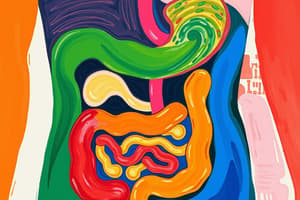Podcast
Questions and Answers
What is the primary purpose of mechanical digestion?
What is the primary purpose of mechanical digestion?
- To secrete digestive juices
- To absorb nutrients into the bloodstream
- To reduce food particle size (correct)
- To chemically transform food into nutrients
Chemical digestion occurs only in the mouth.
Chemical digestion occurs only in the mouth.
False (B)
What is formed when food is mixed with saliva during the process of insalivation?
What is formed when food is mixed with saliva during the process of insalivation?
Bolus
The liquid mush produced in the stomach is known as __________.
The liquid mush produced in the stomach is known as __________.
Which process enables the bolus to travel through the pharynx to the stomach?
Which process enables the bolus to travel through the pharynx to the stomach?
Villi in the small intestine significantly increase the surface area for nutrient absorption.
Villi in the small intestine significantly increase the surface area for nutrient absorption.
What are the three main types of juices that act in the small intestine?
What are the three main types of juices that act in the small intestine?
The __________ wall has a large surface for absorption, approximately 200 metres squared.
The __________ wall has a large surface for absorption, approximately 200 metres squared.
Match the digestive process with its description:
Match the digestive process with its description:
What are microvilli?
What are microvilli?
What is the main role of saliva during the digestive process?
What is the main role of saliva during the digestive process?
Chyme is produced in the small intestine.
Chyme is produced in the small intestine.
What is the term for the half-liquid mush created in the stomach?
What is the term for the half-liquid mush created in the stomach?
The process of __________ consists of tearing and grinding food in the mouth.
The process of __________ consists of tearing and grinding food in the mouth.
Match the digestive processes with their corresponding definitions:
Match the digestive processes with their corresponding definitions:
Which of the following structures is essential in increasing the absorption surface area in the small intestine?
Which of the following structures is essential in increasing the absorption surface area in the small intestine?
The small intestine has a larger absorption surface compared to the stomach.
The small intestine has a larger absorption surface compared to the stomach.
What are intestinal villi and why are they important?
What are intestinal villi and why are they important?
Nutrients absorbed in the small intestine reach the body's cells via the __________.
Nutrients absorbed in the small intestine reach the body's cells via the __________.
Which digestive juices act specifically on proteins in the stomach?
Which digestive juices act specifically on proteins in the stomach?
Flashcards
Mechanical Digestion
Mechanical Digestion
The process of physically breaking down food into smaller pieces to aid digestion. This involves processes like chewing, tearing, and grinding.
Mastication
Mastication
The process of chewing food using your teeth and the movement of your jaw.
Insalivation
Insalivation
Mixing food with saliva in your mouth using your tongue.
Deglutition
Deglutition
Signup and view all the flashcards
Chemical Digestion
Chemical Digestion
Signup and view all the flashcards
Chyme
Chyme
Signup and view all the flashcards
Chyle
Chyle
Signup and view all the flashcards
Absorption in the Small Intestine
Absorption in the Small Intestine
Signup and view all the flashcards
Intestinal Folds
Intestinal Folds
Signup and view all the flashcards
Intestinal Villi
Intestinal Villi
Signup and view all the flashcards
How is food broken down before chemical digestion?
How is food broken down before chemical digestion?
Signup and view all the flashcards
What is the purpose of saliva?
What is the purpose of saliva?
Signup and view all the flashcards
What moves food down the esophagus?
What moves food down the esophagus?
Signup and view all the flashcards
Where does protein digestion begin?
Where does protein digestion begin?
Signup and view all the flashcards
What is chyme?
What is chyme?
Signup and view all the flashcards
What happens to chyme in the small intestine?
What happens to chyme in the small intestine?
Signup and view all the flashcards
What does chyle contain?
What does chyle contain?
Signup and view all the flashcards
How do nutrients reach body cells?
How do nutrients reach body cells?
Signup and view all the flashcards
Why is the small intestine good at absorbing nutrients?
Why is the small intestine good at absorbing nutrients?
Signup and view all the flashcards
What are intestinal villi?
What are intestinal villi?
Signup and view all the flashcards
Study Notes
Types of Digestion
-
Mechanical Digestion: Reduces food particle size for easier transport.
- Mastication: Chewing, tearing, cutting, and grinding food in the mouth using teeth and jaw movements.
- Insalivation: Mixing chewed food with saliva using the tongue, forming a bolus.
- Deglutition: Using peristaltic movements to move the bolus through the pharynx and esophagus to the stomach.
-
Chemical Digestion: Breaks down food into nutrients using digestive juices.
- Mouth: Saliva acts on carbohydrates, breaking them down into simpler substances during bolus formation.
- Stomach: Gastric juices (with pepsin) act on proteins, creating chyme.
- Small Intestine: Intestinal juices, bile, and pancreatic juices act to complete digestion, turning chyme into chyle (containing water, nutrients, and remaining products).
Absorption in the Small Intestine
- High surface area for nutrient absorption (approximately 200 square meters).
- Length: The small intestine is 7-8 meters long.
- Intestinal Mucus (Internal Walls): Tiny structures (folds, villi, microvilli) increase surface area significantly, up to approximately 600 times.
- Folds in the intestinal wall.
- Tiny finger-like projections (villi) covering the folds.
- Even smaller projections (microvilli) on the surface of the villi.
- Extensive network of blood vessels and capillaries within the villi.
Absorption in the Large Intestine
- Absorbs water and minerals.
- Difference from small intestine: Larger diameter (approximately 1 meter) but no villi.
- Gut flora (bacteria): Breakdown undigested material into feces for egestion (defecation) through the anus.
- Dietary fibre: Not digested by human enzymes, therefore cannot be absorbed.
Studying That Suits You
Use AI to generate personalized quizzes and flashcards to suit your learning preferences.




